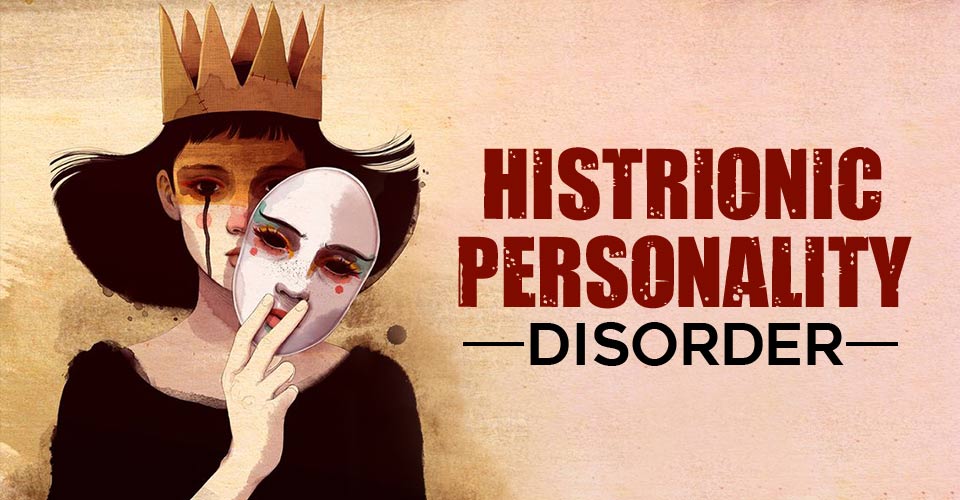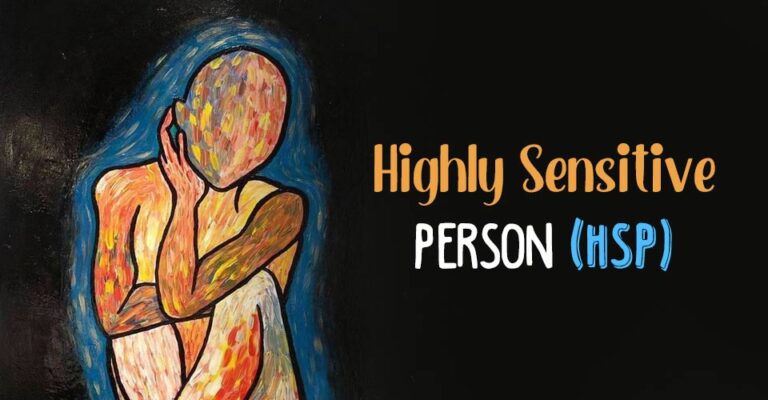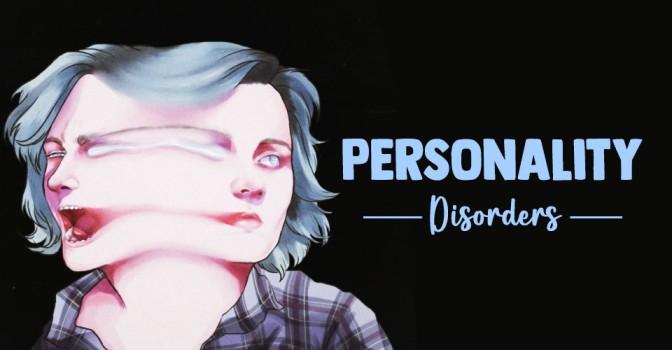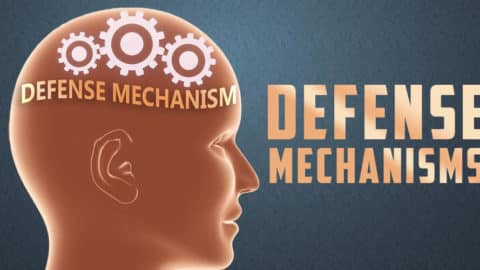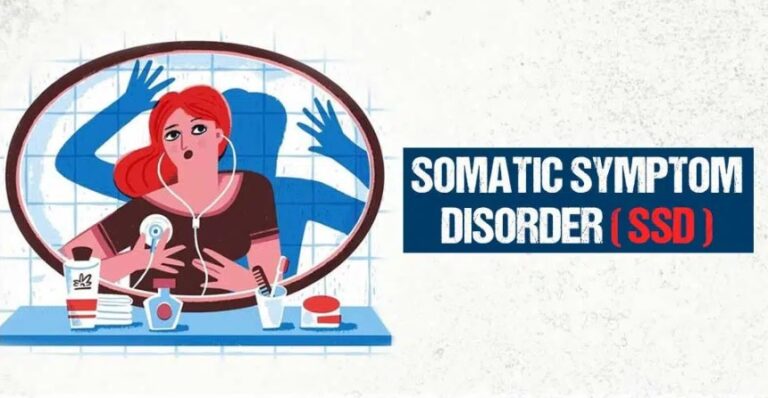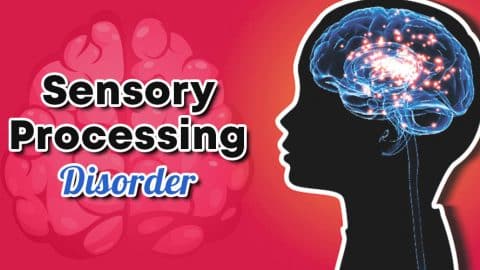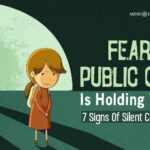Table of Contents
Histrionic Personality Disorder (HPD) is a mental health condition characterized by a pattern of excessive emotionality and attention-seeking behavior. People with HPD often feel uncomfortable when they are not the center of attention and may use dramatic, flirtatious, or provocative behavior to draw others’ focus toward them.
Key Characteristics:
- Attention-seeking behavior: Constant need to be the center of attention, even in inappropriate situations.
- Excessive emotional expression: Emotions can be shallow, rapidly shifting, or overly dramatic.
- Inappropriate seductive behavior: May act flirtatiously or provocatively, even in professional or platonic settings.
- Easily influenced by others: Opinions and feelings can be quickly swayed by people or trends.
- Concern with appearance: May place excessive emphasis on physical appearance to attract attention.
- Overestimation of intimacy: Believes relationships are more intimate than they really are.
Causes & Risk Factors:
- No single cause, but genetic predisposition, early childhood experiences, and inconsistent parenting can contribute.
- Often co-occurs with other personality disorders such as borderline, narcissistic, or dependent personality disorders.
Diagnosis:
Diagnosis is typically made by a mental health professional based on criteria from the DSM-5, including the presence of at least five of the characteristic behaviors listed.
Treatment:
- Psychotherapy is the primary treatment, especially cognitive-behavioral therapy (CBT).
- Medication is not used to treat HPD directly but may help with symptoms like depression or anxiety if present.
What Is Histrionic Personality Disorder?
Histrionic personality disorder (HPD) is a mental disorder that involves a pervasive pattern of hyper-emotional and extreme attention-seeking responses.
Individuals with Histrionic Personality Disorder often display overly dramatic and emotional behaviors in an effort to gain attention from others. They are typically lively, enthusiastic, cheerful, and flirtatious. However, their intense need for approval and attention may lead them to engage in inappropriate or provocative behavior. Symptoms often begin to emerge in early childhood.
The American Psychiatric Association explains that people with this disorder “may be uncomfortable when they are not the center of attention, may use physical appearance to draw attention to themselves or have rapidly shifting or exaggerated emotions.”
Histrionic Personality Disorder (HPD) is classified as a Cluster B personality disorder, characterized by patterns of excessive emotionality and attention-seeking behavior. Individuals with HPD often exhibit theatrical, excitable, and unpredictable traits. They may also come across as demanding, self-centered, dependent, superficial, and lacking consideration for others.
According to the American Psychological Association (APA), the condition was previously known as hysterical personality disorder. The APA explains the condition as “a personality disorder characterized by a pattern of long-term (rather than episodic) self-dramatization in which individuals draw attention to themselves, crave activity and excitement, overreact to minor events, experience angry outbursts, and are prone to manipulative suicide threats and gestures.”
Individuals with Histrionic Personality Disorder often display loud, attention-seeking behavior and exaggerated, sometimes inappropriate emotional reactions. While they can be easily influenced by others, they may also act in self-centered, manipulative, or sexually provocative ways to fulfill their desires or maintain attention.
Research 1 Nestadt, G., Romanoski, A. J., Chahal, R., Merchant, A., Folstein, M. F., Gruenberg, E. M., & McHugh, P. R. (1990). An epidemiological study of histrionic personality disorder. Psychological medicine, 20(2), 413–422. https://doi.org/10.1017/s0033291700017724 indicates that the disorder affects around 2-3% of the population. Men and women are equally affected by the condition. However, hospital-based research indicates that women 2 Rienzi, B. M., & Scrams, D. J. (1991). Gender stereotypes for paranoid, antisocial, compulsive, dependent, and histrionic personality disorders. Psychological reports, 69(3 Pt 1), 976–978. https://doi.org/10.2466/pr0.1991.69.3.976 are four times more likely to be affected by it than men. Treatment based on different psychotherapeutic approaches can help someone overcome the symptoms of HPD and live a more fulfilling life.
History Of Histrionic Personality Disorder
Histrionic Personality Disorder is considered one of the most dubious and ambiguous personality disorders in psychiatry. One 2007 study 3 French JH, Shrestha S. Histrionic Personality Disorder. [Updated 2021 Oct 1]. In: StatPearls [Internet]. Treasure Island (FL): StatPearls Publishing; 2021 Jan-. Available from: https://www.ncbi.nlm.nih.gov/books/NBK542325/ states “Despite its familiar feel, HPD remains enshrouded in a degree of historical confusion and conceptual uncertainty that researchers have not yet resolved.” The condition was originally known as hysterical personality disorder. According to the Encyclopedia of Human Behavior, 2012, “HPD owes its historical origins to the early descriptions of ‘hysteria,’ although it gradually evolved into a more circumscribed diagnosis characterized by theatrical displays and interpersonal dysfunction.”
The term hysteria is derived from the Greek word “Hystera”, which means womb. The term has been widely used in texts by ancient Egyptians, Romans and Greeks. The term hysteria involves a wide range of psychopathological states. Ancient Romans also used the term “Histrione 4 Novais, F., Araújo, A., & Godinho, P. (2015). Historical roots of histrionic personality disorder. Frontiers in psychology, 6, 1463. https://doi.org/10.3389/fpsyg.2015.01463 ” which was used to describe actors who portrayed comic, dramatic and theatrical work. A 2015 study 5 Novais, F., Araújo, A., & Godinho, P. (2015). Historical roots of histrionic personality disorder. Frontiers in psychology, 6, 1463. https://doi.org/10.3389/fpsyg.2015.01463 reveals that HPD was first officially described in the Diagnostic and Statistical Manual of Mental Disorders II (DSM-II). Since the introduction of DSM-III, the condition is the only mental disorder which derives its name from the original concept of hysteria. The term histrionic means excessively theatrical or dramatic.
Understanding Histrionic Personality Disorder
Individuals with Histrionic Personality Disorder often struggle with low self-worth, as their self-esteem is heavily reliant on external validation and approval. Their distorted self-image leads to emotional instability and an intense, persistent need for attention.
DSM-5 Clinical Criteria for HPD: A few example of histrionic personality disorder
According to the Diagnostic and Statistical Manual of Mental Disorders, Fifth Edition (DSM-5) by the American Psychiatric Association (APA), Histrionic Personality Disorder (HPD) is diagnosed when an individual exhibits a pervasive pattern of excessive emotionality and attention-seeking behavior, beginning by early adulthood and present in a variety of contexts. The diagnosis requires the presence of five (or more) of the following traits:
- Uncomfortable when not the center of attention
- Constantly seeks to be noticed and becomes distressed or uneasy when not in the spotlight.
- Interactions often involve inappropriate sexually seductive or provocative behavior
- Tends to use sexuality to draw attention, even in contexts where it’s not appropriate.
- Displays rapidly shifting and shallow expression of emotions
- Emotional expressions may change quickly and seem superficial or exaggerated.
- Consistently uses physical appearance to draw attention to self
- May dress flamboyantly or place extreme focus on looks to gain approval.
- Has a style of speech that is excessively impressionistic and lacking in detail
- Speech may be vague, dramatic, or overly general without clear substance.
- Shows self-dramatization, theatricality, and exaggerated expression of emotion
- Behavior may appear overly emotional or “performative,” even in casual situations.
- Is suggestible (i.e., easily influenced by others or circumstances)
- Readily adopts others’ opinions, moods, or behaviors, often to maintain approval.
- Considers relationships to be more intimate than they actually are
- May misinterpret the closeness of acquaintances or casual relationships.
These traits must cause significant impairment in social, occupational, or other areas of functioning, and they must not be better explained by another mental disorder.
Individuals with Histrionic Personality Disorder (HPD) often experience discomfort, a sense of being ignored, or underappreciation in social situations where they are not the center of attention. They typically present with a bold, captivating presence and are often seen as the “life of the party.” These individuals tend to be charming, energetic, and overly seductive, frequently using bright, revealing clothing and physical appearance to attract attention—even when they are not genuinely emotionally, physically, or sexually interested in others.
Their emotional expressions are often shallow, inconsistent, and exaggerated, which may come across as insincere or theatrical to others. Communication is often vague or lacking in detail, yet delivered with intense emotional flair. They are prone to dramatic public displays of emotion and affection, which can feel excessive or inappropriate in certain settings.
People with HPD are also highly suggestible and easily influenced by those they admire or seek approval from. As a result, they may adopt others’ opinions, behaviors, or beliefs without critical reflection. Additionally, they frequently misinterpret the depth of their relationships, assuming emotional intimacy that may not actually exist.
Comorbid Conditions
Histrionic personality disorder overlaps with some other psychiatric conditions, including –
- Borderline personality disorder
- Somatization disorder
- Antisocial personality disorder
However, all these disorders are unique and different from each other. Research 6 Lilienfeld, S. O., Van Valkenburg, C., Larntz, K., & Akiskal, H. S. (1986). The relationship of histrionic personality disorder to antisocial personality and somatization disorders. The American journal of psychiatry, 143(6), 718–722. https://doi.org/10.1176/ajp.143.6.718 indicates that men with HPD can develop antisocial personality disorder and women with HPD are highly likely to develop somatization disorder. Moreover, the researchers state that “all three conditions may represent alternative manifestations or different stages of the same underlying diathesis.”
According to The Merck Manuals, histrionic people may also possess traits of narcissistic personality disorder as well. It states that these related disorders “share a biologic vulnerability or casting doubt on whether histrionic personality disorder is a separate disorder.” Apart from these, patients with HPD may also experience “major depressive disorder, persistent depressive disorder, and conversion disorder” as these conditions may also coexist. Other comorbid conditions may include:
- Dependent personality disorder
- Anxiety disorders
- Panic disorder
- Eating disorders
- Conversion disorders
- Post traumatic stress disorder (PTSD), including dissociative disorders
- Attachment disorders, like reactive attachment disorder
- Body dysmorphic disorder
- Substance abuse
- Anorexia nervosa
- Other psychiatric disorders
Read More About Anorexia Nervosa Here
Types Of Histrionic Personality Disorder
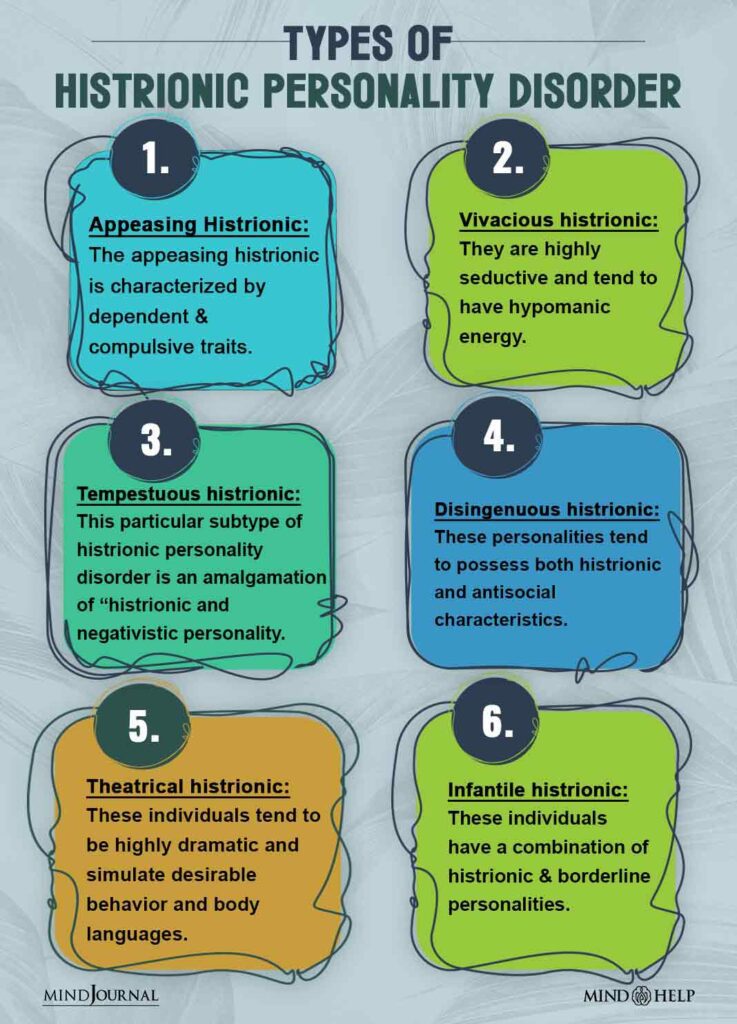
Although the DSM identifies only one type of histrionic personality disorder, a 2004 study by American psychologist Theodore Millon and colleagues recognized 6 different types of HPD based on the specific traits and behaviors of the histrionic person. The 6 different HPD types are:
- Appeasing histrionic
- Vivacious histrionic
- Tempestuous histrionic
- Disingenuous histrionic
- Theatrical histrionic
- Infantile histrionic
Here is a brief look at the different types of HPD as identified by Millon:
1. Appeasing Histrionic
The appeasing subtype of Histrionic Personality Disorder is marked by strong dependent and compulsive tendencies. These individuals are driven by an intense need to be liked and often attempt to form friendships with nearly everyone they encounter. They frequently rely on praise, flattery, and charm to win approval and may become visibly distressed or desperate if others seem indifferent to them.
Their overwhelming desire for acceptance can lead them to avoid conflict at all costs, often giving in or surrendering in disagreements. This behavior may stem from deep-rooted feelings of helplessness, inferiority, emptiness, or guilt associated with their compulsive need to please. They are quick to compromise and make personal sacrifices to maintain harmony, even in unhealthy situations.
These individuals can be excessively eager to please, sometimes to the extent of placating or appeasing those who mistreat them. As a result, they may endure neglect, emotional abuse, or even violence—simply to avoid rejection or maintain a sense of belonging.
2. Vivacious Histrionic
Vivacious histrionics are intensely seductive individuals who often display hypomanic energy. They may exhibit some narcissistic traits and are typically seen as charming, lively, impulsive, and full of vigor. Their primary focus is often on capturing immediate attention and experiencing short-term gratification, rather than forming meaningful or lasting connections.
These individuals are playful, adventurous, and socially magnetic, but they often lack awareness of the potential consequences of their actions. In relationships, they may be prone to infidelity and are likely to pursue new romantic interests before fully ending their current ones. Despite possessing narcissistic features, they can be emotionally vulnerable and may find themselves in relationships with abusive partners, drawn by the intensity rather than the health of the connection.
3. Tempestuous Histrionic
This particular subtype of histrionic personality disorder is an amalgamation of “histrionic and negativistic personality 7 Hopwood, C. J., & Wright, A. G. (2012). A comparison of passive-aggressive and negativistic personality disorders. Journal of personality assessment, 94(3), 296–303. https://doi.org/10.1080/00223891.2012.655819 .” They tend to be pessimistic, critical and skeptical and may refuse to act on suggestions repeatedly. They are also highly moody, impulsive, impassioned, turbulent, out of control and prone to complaining and sulking. Tempestuous histrionics also tend to be emotionally variable, argumentative and confrontational. They may pretend to be superficially sociable and friendly, but they are socially immature, intolerant of frustration and sensitive to criticism.
4. Disingenuous Histrionic
These personalities tend to possess both histrionic and antisocial characteristics. They tend to be manipulative, aggressive & hostile and are prone to violate social norms. Although they may appear charming and friendly initially, these personalities may exploit others after gaining their trust. These individuals are often described as deceitful, egocentric, scheming, guileful and insincere. As they don’t like being perceived as weak, they can resort to predatory behavior to create their preferred impression on others. Disingenuous histrionics may also have psychopathic characteristics and tend to combine the charm and adaptive social skills of the histrionic with the deliberate malevolence of the sociopath or psychopath. They tend to enjoy conflict and may be prone to homicidal behavior 8 Petherick, W., & Petherick, N. (2019). Psychological influences on homicide. Homicide, 49-79. https://doi.org/10.1016/b978-0-12-812529-8.00003-3 .
5. Theatrical Histrionic
The theatrical subtype of Histrionic Personality Disorder represents the most classic and overt expression of the condition. These individuals are highly dramatic, often mimicking idealized behaviors and exaggerated body language to attract attention. They are skilled at presenting themselves in a polished, appealing manner—essentially “marketing” themselves as desirable to others.
Like social chameleons, they can shift their personality, traits, and demeanor depending on the situation or audience, often fabricating aspects of their identity to enhance their charm. This adaptability, however, stems from a lack of a stable or deeply developed sense of self. Their primary focus lies in being seductive, likable, and visually attractive rather than cultivating genuine self-awareness or emotional depth.
Women with this presentation may favor bold, eye-catching clothing and accessories to enhance their visibility, while men may emphasize their physical appearance, often through bodybuilding or a strong focus on fitness, to project appeal and strength.
6. Infantile Histrionic
The infantile subtype of Histrionic Personality Disorder combines features of both histrionic and borderline personality traits. These individuals often struggle with deep dependency issues and display emotionally unstable, demanding, and overly reactive behavior. Their emotional responses are intense and erratic, frequently resembling childlike hysteria or tantrums.
Infantile histrionics often gravitate toward powerful or dominant figures, seeking protection and approval, and may use premature sexuality as a means to gain affection or attention in relationships. While they appear indulgent and pleasure-seeking, they are also excessively clingy and prone to forming unhealthy, codependent attachments.
Lacking a stable sense of self, they focus heavily on external validation and struggle with feelings of emptiness when they don’t receive the attention or reassurance they crave. In relationships, they can be overly dependent, constantly needing affirmation, and may become depressed or emotionally dysregulated when that validation is withheld.
Histrionic Personality Disorder Symptoms
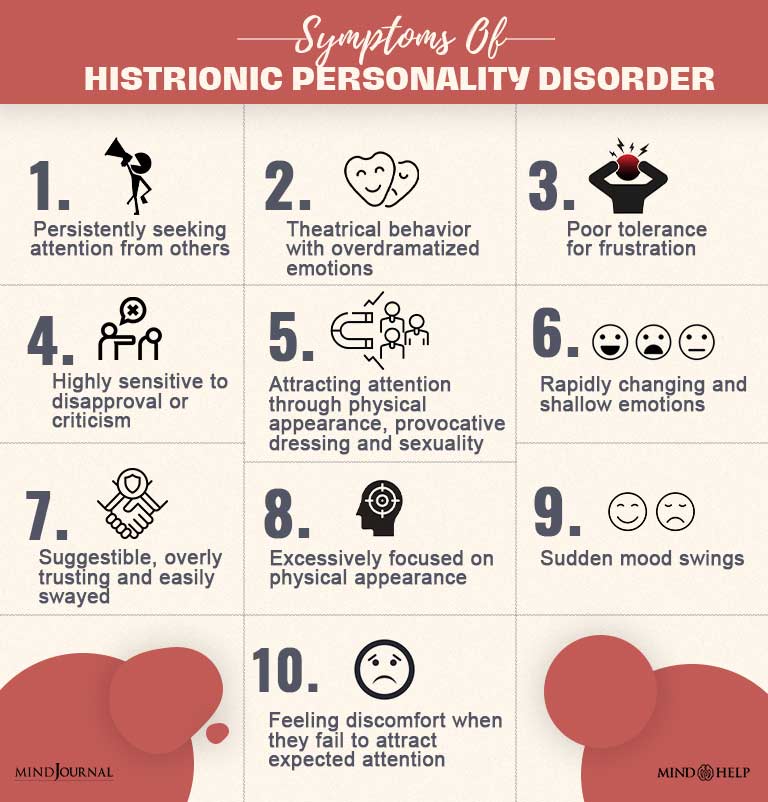
Individuals with Histrionic Personality Disorder (HPD) are often perceived as overly dramatic, emotionally intense, and unpredictable. They tend to be lively, attention-seeking, and are frequently described as flirtatious or “the life of the party.” Below are some of the most common symptoms associated with HPD:
- A constant need to be the center of attention
- Dramatic, exaggerated emotional displays and theatrical behavior
- Using physical appearance, provocative clothing, or sexuality to draw attention
- Discomfort or distress when not receiving the desired attention
- Obsession with appearance and how they are perceived
- Frequent need for approval, validation, or reassurance
- Shallow, rapidly shifting emotional expressions
- Inappropriate flirtatious or seductive behavior
- Easily influenced, overly trusting, and suggestible
- Vague or impressionistic speech that lacks detail
- Quickly bored and always seeking stimulation, excitement, or new relationships
- Sudden emotional swings without clear cause
- Misinterpreting relationships as more intimate than they truly are
- Low frustration tolerance and difficulty managing disappointment
- Overly sensitive to criticism or perceived rejection
- Impulsive decision-making without considering consequences
- Self-focused with limited empathy for others
- Threats or signs of suicidal behavior when feeling ignored or rejected
According to a 2018 study 9 Ritzl, A., Csukly, G., Balázs, K., & Égerházi, A. (2018). Facial emotion recognition deficits and alexithymia in borderline, narcissistic, and histrionic personality disorders. Psychiatry research, 270, 154–159. https://doi.org/10.1016/j.psychres.2018.09.017 , people with histrionic personality disorder may also be affected by alexithymia. This condition makes it difficult for the individual to identify or express emotions. They may also use dissociation and repression as a defense mechanism. They also have higher risk for developing depression. It is also difficult for histrionic people to experience healthy emotional or sexual intimacy. “Patients may, often without being aware of it, play a role (eg, victim). They may try to control their partner using seductiveness or emotional manipulations while becoming very dependent on the partner,” explains The Merck Manuals.
Usually, the symptoms of histrionic personality disorder tend to appear during early childhood. However, onset may also occur during early adulthood as well. If someone has some of these features but is able to function effectively in their daily life, then they might not necessarily be affected by HPD. Personality disorders cause long-term distress in the life of the sufferer and disrupt their ability to function normally. People with HPD do not behave this way deliberately and often find it difficult to change their behavior.
Histrionic Personality Disorder vs Borderline Personality Disorder
Categorized under cluster B personality disorders, both borderline personality disorder and histrionic personality disorder are characterized by overly emotional, dramatic, and erratic thinking & behavior. Both the disorders tend to have overlapping symptoms. Patients of both HPD and BPD have reactive and rapidly shifting emotions and usually depict impulsive behavior.
Research 10 Angstman, K. B., & Rasmussen, N. H. (2011). Personality disorders: review and clinical application in daily practice. American family physician, 84(11), 1253–1260. indicates that both these personality disorders involve overly strong expression of emotions. One study 11 Turner R.M. (1994) Borderline, Narcissistic, and Histrionic Personality Disorders. In: Hersen M., Ammerman R.T. (eds) Handbook of Prescriptive Treatments for Adults. Springer, Boston, MA. https://doi.org/10.1007/978-1-4899-1456-9_19 by Ralph M. Turner of the Department of Psychiatry in Lewis Katz School of Medicine at Temple University in Philadelphia, USA, states “These disorders appear to have many common features and often co-occur in patients. These are the disorders of the self.”
However, many experts argue that these symptoms often vary in their quality in HPD and BPD. For instance, the rapidly shifting emotions experienced by patients of BPD lack the depth and intensity of the same symptom experienced by people with HPD. Certain researchers tend to believe that although HPD and BPD may possess different features and traits, these may not necessarily be different disorders.
Irrespective of the controversy and debate, HPD is a unique and specific diagnosis in the DSM-5. It has also been observed that histrionic personality disorder and borderline personality disorder frequently co-occur 12 Bakkevig, J. F., & Karterud, S. (2010). Is the diagnostic and statistical manual of mental disorders, fourth edition, histrionic personality disorder category a valid construct? Comprehensive Psychiatry, 51(5), 462-470. https://doi.org/10.1016/j.comppsych.2009.11.009 in some patients. As most of the symptoms overlap, it can often be difficult to diagnose the conditions in someone properly. Further studies 13 Tomko, R. L., Trull, T. J., Wood, P. K., & Sher, K. J. (2014). Characteristics of borderline personality disorder in a community sample: Comorbidity, treatment utilization, and general functioning. Journal of Personality Disorders, 28(5), 734-750. https://doi.org/10.1521/pedi_2012_26_093 have revealed that around 10% of individuals with BPD also tend to meet the diagnostic criteria for HPD.
Causes Of Histrionic Personality Disorder
The exact cause of Histrionic Personality Disorder (HPD) remains unclear, but research suggests that it likely develops from a combination of genetic, psychological, and environmental influences. Factors such as childhood trauma, abuse, neglect, or inconsistent parenting may contribute to the onset of HPD. In some cases, overly indulgent or attention-focused environments during formative years may also play a role. High levels of stress and anxiety in early life can further increase vulnerability to developing the disorder.
Many experts support the biopsychosocial model, which views HPD as a result of interactions between biological predispositions, psychological development, and social experiences. Biological factors include inherited personality traits or imbalances in brain chemistry. Psychological factors involve learned behaviors, emotional regulation, and coping mechanisms shaped by early life experiences. Social factors relate to relationships with caregivers, family dynamics, peer interactions, and cultural influences during childhood.
Below are some of the most commonly believed contributors to the development of HPD:
1. Genetics
Cluster B personality disorders may run in families. According to a 2013 study 14 Torgersen, S., Myers, J., Reichborn-Kjennerud, T., Røysamb, E., Kubarych, T. S., & Kendler, K. S. (2012). The heritability of Cluster B personality disorders assessed both by personal interview and questionnaire. Journal of personality disorders, 26(6), 848–866. https://doi.org/10.1521/pedi.2012.26.6.848 , personal interview and questionnaire assessment has revealed that cluster B personality disorders, like HPD and BPD, may have a strong heritability. The authors of the study state that “When Cluster B PDs are assessed by interview as well as by questionnaire, the heritability is high, just as high as it is for schizophrenia.” If you suffer from HPD then it is highly likely that the condition may be passed down to your children. If you have a first-degree family member or relative with HPD, then it is likely that multiple members of your family, including you, may develop the disorder.
According to the American Psychological Association (APA), researchers may have identified certain malfunctioning genes that may cause certain personality disorders. Moreover, “researchers are exploring genetic links to aggression, anxiety and fear – traits that can play a role in personality disorders,” states the APA. Moreover, twin studies 15 Torgersen, S., Lygren, S., Øien, P. A., Skre, I., Onstad, S., Edvardsen, J., Tambs, K., & Kringlen, E. (2002). A twin study of personality disorders. ScienceDirect.com | Science, health and medical journals, full text articles and books. https://www.sciencedirect.com/science/article/abs/pii/S0010440X00982841?via%3Dihub conducted by Oslo University have revealed an association between Cluster B personality disorders and genetics. The study revealed a 0.67 correlation that HPD is hereditary.
2. Parenting styles
Parenting styles can also play a crucial role in the development of histrionic personality disorder. When a child observes 16 Sulz S. (2010). Hysterie I: Histrionische Persönlichkeitsstörung. Eine psychotherapeutische Herausforderung [Hysteria I. Histrionic personality disorder. A psychotherapeutic challenge]. Der Nervenarzt, 81(7), 879–888. https://doi.org/10.1007/s00115-010-3016-6 their parent or primary caregiver displaying inappropriate, volatile, dramatic, erratic or oversexualized attitudes and behavior, then it is highly likely that the child may have a histrionic personality. The child may display behavior that they have learned from their caregivers or parents. Children may also learn and exhibit HPD behaviors in order to gain attention from their parents.
A recent scientific analysis on HPD reveals that “Parenting which lacks boundaries is over-indulgent or inconsistent may predispose children to develop histrionic personality disorder.” Overindulgent parenting may also lead to the development of this condition in early adulthood. As such neglectful caregiving fails to establish any boundaries, it affects the healthy psychological and emotional development of a child. “Moreover, parents who role model dramatic, erratic, volatile, or inappropriate sexual behavior put their children at high risk for developing this personality disorder,” adds the scientific analysis.
3. Traumatic experiences
Childhood “abuse, trauma or neglect” can also increase the risk of developing HPD. Excessive stress, such as financial problems or the loss of a loved one can also be a contributing factor. Family dynamics and frequent issues in the family can also influence the onset. For instance, if a child is rewarded for dramatic or theatrical behavior or if there is a lack of discipline, it is likely that they will become a histrionic person.
According to the recent scientific analysis on HPD, trauma experienced during childhood can result in the condition. It states “Children may endure their trauma by coping with their environment in ways that may ultimately lead to a personality disorder.” Personality disorders in childhood may be a manifestation of a traumatic situation or traumatic environment in childhood and may develop as a coping mechanism.
The APA explains that the role of childhood experiences can be more significant than expected, according to studies. It states “One study 17 Yen, S., Shea, M. T., Battle, C. L., Johnson, D. M., Zlotnick, C., Dolan-Sewell, R., Skodol, A. E., Grilo, C. M., Gunderson, J. G., Sanislow, C. A., Zanarini, M. C., Bender, D. S., Rettew, J. B., & McGlashan, T. H. (2002). Traumatic exposure and posttraumatic stress disorder in borderline, schizotypal, avoidant, and obsessive-compulsive personality disorders: findings from the collaborative longitudinal personality disorders study. The Journal of nervous and mental disease, 190(8), 510–518. https://doi.org/10.1097/00005053-200208000-00003 found a link between the number and type of childhood traumas and the development of personality disorders.” Physical, emotional, verbal and sexual abuse can also increase the risk for developing personality disorders in adulthood.
Read More About Post-Traumatic Stress Disorder Here
4. Brain structure
Sometimes brain anatomy and functioning may also affect our personality & behavior leading to the development of certain mental and personality disorders. The human brain produces and releases certain chemicals that significantly affect our thoughts, emotions & actions. When these brain chemicals are out of balance, then it may adversely affect how we feel, behave, think and act. A person suffering from histrionic personality disorder may behave in a certain way due to a disbalance in brain chemicals.
Studies reveal that people with HPD tend to have “highly responsive noradrenergic systems, the mechanisms surrounding the release of a neurotransmitter called norepinephrine.” The excessively emotional behavior exhibited by patients with HPD can be attributed to disbalance in a type of neurotransmitters known as catecholamines 18 Goldstein D. S. (2010). Catecholamines 101. Clinical autonomic research : official journal of the Clinical Autonomic Research Society, 20(6), 331–352. https://doi.org/10.1007/s10286-010-0065-7 .
5. Personal factors
Apart from genetics, parental styles, childhood experiences and brain anatomy, personal variables may also influence the onset of histrionic personality disorder. Researchers have found an association between HPD behaviors and age of the person. Although HPD symptoms tend to be long-term, certain characteristic traits of the condition may vary depending on the age of the patient.
For instance, a young person with HPD may be more prone to use their physical appearance and sexuality to attract attention and praise from others than an older adult. Older adults with HPD may use their intellect, social status and paternal/maternal seductiveness to gain attention. Moreover, the intensity of attention-seeking behavior may also vary with the age of the individual with HPD.
Complications Of Histrionic Personality Disorder
When left untreated, Histrionic Personality Disorder (HPD) can lead to various complications that significantly impact an individual’s personal, social, and professional life. For example, frequent engagement in overly sexualized or provocative behavior can damage one’s social reputation and hinder the ability to form stable, long-term romantic relationships. Additionally, individuals with HPD may react with anger or emotional outbursts when faced with criticism or rejection, making it challenging to function effectively in demanding work environments or maintain healthy professional relationships.
People with Cluster B personality disorders, including HPD, often seek constant stimulation and novelty. This craving for excitement can lead to impulsive or risky behaviors, such as substance abuse, reckless decisions, or unstable relationships. They may also be highly prone to emotional disturbances like anxiety and depression. In many cases, individuals with HPD experience these co-occurring symptoms alongside the core traits of the disorder, further complicating their emotional and mental well-being.
When To Consult A Doctor
Since individuals with Histrionic Personality Disorder often appear socially engaging and may function well in everyday situations, they may not recognize that anything is wrong or feel the need to seek help. However, when their symptoms begin to interfere with their quality of life—damaging personal relationships, disrupting academic or career goals, or causing emotional distress—it becomes important to consult a mental health professional.
Additionally, if co-occurring conditions such as anxiety, depression, or substance use become more severe, seeking treatment becomes essential for managing both HPD and the associated challenges.
The American Psychiatric Association states “More severe or long lasting symptoms may require a team approach involving a primary care doctor, a psychiatrist, a psychologist, social worker and family members.”
Diagnosis Of Histrionic Personality Disorder
Diagnosing Histrionic Personality Disorder (HPD) can be challenging, especially because it often coexists with other personality disorders, such as Borderline Personality Disorder (BPD). Mental health professionals typically rely on a combination of behavioral observations, patient history, and clinical interviews—either structured or unstructured—to assess the condition.
According to the Diagnostic and Statistical Manual of Mental Disorders, 5th Edition (DSM-5) by the American Psychiatric Association, a diagnosis of HPD requires the presence of at least five of the following criteria:
- Discomfort in situations where they are not the center of attention
- Inappropriate sexually seductive or provocative behavior during social interactions
- Rapidly shifting and shallow emotional expressions
- Consistent use of physical appearance to draw attention
- A speech style that is excessively impressionistic and lacking in detail
- Dramatic, theatrical, and exaggerated expression of emotions
- High suggestibility—easily influenced by others or external circumstances
- A tendency to perceive relationships as more intimate than they truly are
According to Healthdirect Australia, HPD can only be diagnosed “in an adult, not a child, and should be made only by a psychiatrist or clinical psychologist who gets to know the person over a period of time.” Personality disorders are usually diagnosed by trained and experienced mental health professionals, like a psychiatrist, a psychologist or a therapist. General practitioners and family physicians are typically not trained to diagnose psychological conditions and personality disorders. So even though a patient may consult a general physician for the initial consultation, they need to visit a mental health professional for accurate diagnosis & treatment.
The mental disorder cannot be diagnosed using any specific laboratory or blood test. However, a healthcare professional may use the DSM-5 criteria and ask the patient about their symptoms to assess the condition. Moreover, the person also must experience extensive and regular signs of emotional dysregulation.
A doctor may:
- Analyze the patient’s medical and family history
- Assess mental status through a comprehensive interview
- Ask about the thoughts and feelings of the patient
- Ask about their relationships with family members, friends and peers
- Conduct a family session to evaluate consistent behavior patterns
- Conduct a personality test
The doctor may also conduct certain lab tests to determine if the symptoms are caused by any other medical or psychological problems, medications or substance and alcohol abuse. Unfortunately, most people with HPD are reluctant to seek treatment as they do not believe that they have a personality disorder, making diagnosis more difficult. However, once the condition starts to affect their daily functioning, they may be compelled to consult a mental health professional.
Treatment Of Histrionic Personality Disorder
Generally, individuals with HPD are reluctant to seek treatment and they believe that they do not need therapy. However, if a patient is determined to change their psychological and emotional state, then personality disorders can be effectively treated. “General treatment of histrionic personality disorder is the same as that for all personality disorders,” explains The Merck Manuals.
Although more research is needed, clinicians and experts believe that a patient can successfully overcome the symptoms of HPD with psychotherapy and medications. If the patient has symptoms for other mental conditions, like anxiety, depression, borderline personality disorder or other comorbid conditions, then these disorders should also be addressed and treated as well.
Typically, treatment for HPD primarily includes long-term psychotherapy under the supervision of a trained therapist experienced with treating personality disorders. A doctor may also prescribe certain medicines for specific troubling symptoms, such as stress, anxiety, depression, drug and alcohol use erc.
Here are some of the most effective treatment options available for histrionic personality disorder:
1. Psychotherapy
Therapy is perhaps the most recommended type of treatment for this personality disorder. Psychotherapy 19 Gabbard G. O. (2000). Psychotherapy of personality disorders. The Journal of psychotherapy practice and research, 9(1), 1–6. is a form of counseling that enables the patient to gain insight and understand the fears, anxieties and motivations related to their own thoughts, emotions and behaviors. This can help them to better cope with difficult emotions and connect with other people in a more positive way. It can also encourage the patient to talk more openly about their thoughts and feelings. The American Psychiatric Association states “Psychotherapy can help a person understand the effects of their behavior on others and learn to manage or cope with symptoms and to reduce behaviors causing problems with functioning and relationships.”
However, therapy can often be challenging for people with HPD as they tend to exaggerate and over-dramatize their symptoms or their functioning ability. Therapy and the therapist must be solution-focused and supportive as the patient is likely to defy the behavioral boundaries established by their therapist and act in an emotionally needy way. Here are some common and effective psychotherapy options available for people with HPD:
A. Cognitive behavioral therapy (CBT)
CBT is an efficient way to help histrionic personalities to identify and modify their unconscious thoughts and perspectives regarding themselves, others and the world in general. It can also help them become more aware of negative and unhealthy patterns of impulsive and erratic behavior. Cognitive-behavioral therapy can enable patients to think, behave and react in a calmer and more considerate way with deliberation & contemplation.
A 2010 study 20 Matusiewicz, A. K., Hopwood, C. J., Banducci, A. N., & Lejuez, C. W. (2010). The effectiveness of cognitive behavioral therapy for personality disorders. The Psychiatric clinics of North America, 33(3), 657–685. https://doi.org/10.1016/j.psc.2010.04.007 by Alexis K. Matusiewicz and colleagues states “Research generally supports the conclusion that CBT is an effective treatment modality for reducing symptoms and enhancing functional outcomes among patients with PDs (personality disorders), thereby making it a useful framework for clinicians working with patients with PD symptomatology.”
CBT for HPD patients may involve specific techniques, like assertiveness training and modeling behavior which can help individuals manage their theatrical and dramatic behavior in a social or professional setting. Another 2006 study 21 Davidson, K., Norrie, J., Tyrer, P., Gumley, A., Tata, P., Murray, H., & Palmer, S. (2006). The effectiveness of cognitive behavior therapy for borderline personality disorder: results from the borderline personality disorder study of cognitive therapy (BOSCOT) trial. Journal of personality disorders, 20(5), 450–465. https://doi.org/10.1521/pedi.2006.20.5.450 claims that “CBT can deliver clinically important changes in relatively few clinical sessions in real clinical settings,” for patients with personality disorders, like HPD. CBT can also help in coping with anxiety and depression as well.
Read More About Cognitive behavioral therapy (CBT) Here
B. Cognitive analytic therapy (CAT)
This is a form of talking therapy that aims to improve how the patient feels, thinks, behaves and acts. One 2007 study 22 Kellett S. (2007). A time series evaluation of the treatment of histrionic personality disorder with cognitive analytic therapy. Psychology and psychotherapy, 80(Pt 3), 389–405. https://doi.org/10.1348/147608306X161421 reveals that cognitive analytic therapy (CAT) can be effective in the treatment of histrionic personality disorder. It states “analysis of the general measures illustrated clinically significant change, indexing personality integration and reductions to depression.” Research also indicates that CAT can significantly help to alleviate the severity of the symptoms of histrionic personality disorder. However, more research is required to analyze the effectiveness of this form of psychotherapy.
C. Functional analytic psychotherapy (FAP)
This is another successful way to treat certain personality disorders, like narcissistic and histrionic personality disorder behaviors. According to one 2003 study 23 Callaghan, G.M., Summers, C.J. & Weidman, M. The Treatment of Histrionic and Narcissistic Personality Disorder Behaviors: A Single-Subject Demonstration of Clinical Improvement Using Functional Analytic Psychotherapy. Journal of Contemporary Psychotherapy 33, 321–339 (2003). https://doi.org/10.1023/B:JOCP.0000004502.55597.81 , functional analytic psychotherapy “treatment produced significant changes in these behaviors both statistically and qualitatively.” This form of therapy enables the therapist and the patient to recognize the interpersonal problems as they occur during and out of therapy sessions. The goals of the therapy are usually set by the therapist based on the patient’s behaviors and their need for improvement. FAP 24 Functional Analytic Psychotherapy: Creating Intense and Curative Therapeutic Relationships is different from conventional psychotherapy as here the therapist directly observes, analyzes and communicates the patterns of behavior of the histrionic person as it happens in-session.
In their 2010 study, researcher Alexis K. Matusiewicz and colleagues explain “As target behaviors occur in session, the therapist blocks or reinforce them using natural contingencies (e.g., sharing feelings that the patient has evoked in the therapist), with the goal of creating behavioral change that generalizes to daily life.” The researchers claim that functional analytic psychotherapy is a “radical behavioral approach,” where the therapist utilizes reinforcement principles to change and improve the behavior of the patient.
D. Psychodynamic psychotherapy
This form of therapy has been found to be effective in treating patients with a histrionic personality disorder. Also known as insight-oriented therapy, this form of therapy focuses on identifying and revealing the underlying causes for the onset of HPD to reduce the emotional reactivity of the patient. According to a recent scientific analysis on HPD, “Psychodynamic psychotherapy aims to resolve underlying, unconscious conflicts in an effort for patients to understand themselves and their behaviors better.”
It aims to change certain aspects of the individual’s dysfunctional personality by incorporating important developmental accomplishments that may have not been accounted for during their previous emotional maturation stages. Psychodynamic therapy 25 Gonzalez-Torres M. A. (2018). Psychodynamic psychotherapies for borderline personality disorders. Current developments and challenges ahead. BJPsych international, 15(1), 12–14. https://doi.org/10.1192/bji.2017.7 motivates patients to replace intense dramatic behaviors with more adaptive behaviors and encourages enhanced communication with others. The Merck Manuals explain “The therapist may start by encouraging patients to substitute speech for behavior, and thus, patients can understand themselves and communicate with others in a less dramatic way.” It can also help them realize that attention-seeking behaviors can be damaging and enable them to build their self-esteem in healthier ways.
E. Holistic therapies
Apart from therapy, certain relaxation techniques and practices like yoga, meditation, breathing techniques, biofeedback, Tai Chi and other holistic mind-body practices can also prove to be highly helpful for someone with a histrionic personality. These practices can help to manage their stress, anxiety and depression and enable them to control their emotional reflexes by reprogramming their thoughts and mindset.
Studies 26 Crescentini, C., Matiz, A., Cimenti, M., Pascoli, E., Eleopra, R., & Fabbro, F. (2018). Effect of Mindfulness Meditation on Personality and Psychological Well-being in Patients with Multiple Sclerosis. International journal of MS care, 20(3), 101–108. https://doi.org/10.7224/1537-2073.2016-093 claim that mindfulness-oriented meditation can substantially help to improve a person’s mental health and positively influence their personality profiles. Another 2009 study 27 Dakwar, E., & Levin, F. R. (2009). The emerging role of meditation in addressing psychiatric illness, with a focus on substance use disorders. Harvard review of psychiatry, 17(4), 254–267. https://doi.org/10.1080/10673220903149135 found that Buddhist meditation, transcendental meditation and mindfulness-based meditation can be effective in addressing mental conditions, particularly the ones involving substance use disorders. It states “In addition to evidence-based medical uses, meditation may have psychiatric benefits.”
F. Other therapy techniques
Apart from these, some other therapy techniques may also be recommended for a person affect with histrionic personality disorder, such as:
- Talk therapy
- Behavior therapy
- Group therapy
- Family and couples therapy
- Supportive psychotherapy
- Psychoeducation
Read More About Group Therapy Here
2. Medications
There is no specific medication for the treatment of histrionic personality disorder. But as HPD may result in affective dysregulation leading to tearfulness, anger, mood swings, depression and anxiety in the patient, medication may be helpful for recovery. Although medication may not be typically recommended, a doctor may prescribe certain medicines to manage symptoms associated with comorbid conditions, like major depressive disorder or panic disorder. Even though the United States Food and Drug Administration (FDA) has not approved any specific medication for the treatment of this psychiatric condition, doctors may prescribe mood stabilizers, antipsychotics, antidepressants or antianxiety medication for treating affective dysregulation.
Clinical trials 28 Sulz S. (2010). Hysterie I: Histrionische Persönlichkeitsstörung. Eine psychotherapeutische Herausforderung [Hysteria I. Histrionic personality disorder. A psychotherapeutic challenge]. Der Nervenarzt, 81(7), 879–888. https://doi.org/10.1007/s00115-010-3016-6 have shown that mood stabilizers, such as lithium, valproate, topiramate, carbamazepine and lamotrigine, can be especially helpful in managing impulse control and behavior regulation problems commonly experienced by patients with histrionic personality disorder. Moreover, antipsychotics, such as haloperidol, olanzapine, aripiprazole and risperidone can also help in relieving affective dysregulation symptoms. Antidepressants 29 Morrison, J. (1989). Histrionic personality disorder in women with Somatization disorder. Psychosomatics, 30(4), 433-437. https://doi.org/10.1016/s0033-3182(89)72250-7 , like fluvoxamine, amitriptyline, fluoxetine and desipramine, have proven effective for treating symptoms of HPD.
Apart from therapy and medication, doctors may also recommend intensive outpatient or inpatient treatment programs in mental health hospitals or treatment facilities for certain HPD patients, especially those who seek mental peace and psychological & social support during the initial phases of recovery.
Read More About Antidepressants Here
Can Histrionic Personality Disorder Be Prevented?
There is no definitive method to prevent the onset of Histrionic Personality Disorder. However, early diagnosis and timely intervention by a mental health professional can make a significant difference. With appropriate treatment, individuals with HPD can develop healthier coping mechanisms, manage their emotions more effectively, and respond to challenging situations in more constructive ways.
Coping Strategies For Histrionic Personality Disorder
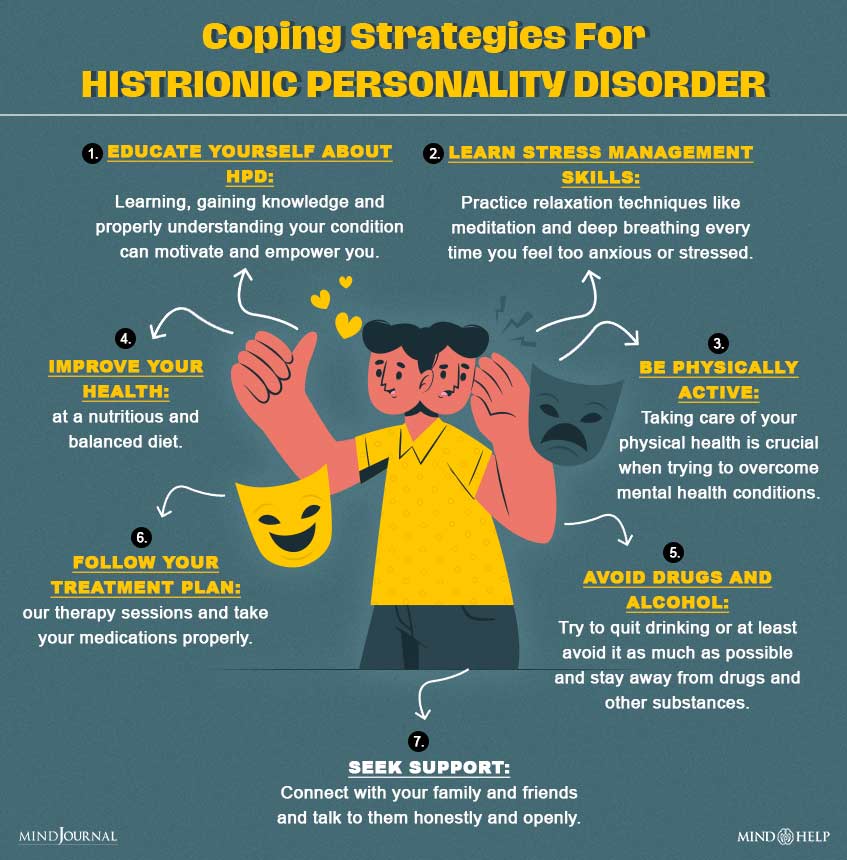
Certain self-help strategies, in addition to treatment, can prove effective in relieving symptoms for individuals with personality disorders. Here are some helpful self-care and coping strategies for people with HPD:
1. Educate yourself about HPD
Learning, gaining knowledge and properly understanding your condition can motivate and empower you.
2. Learn stress management skills
Practice relaxation techniques like meditation and deep breathing every time you feel too anxious or stressed. Do things that you enjoy like eating good food, reading, watching movies, listening to music, or simply taking a walk outside.
3. Be physically active
Taking care of your physical health is crucial when trying to overcome mental health conditions. Get physically active and exercise regularly as it can manage symptoms of anxiety and depression.
4. Improve your health
Eat a nutritious and balanced diet. Moreover, you should get at least 7 to 9 hours of undisturbed sleep every day. Restrict your consumption of caffeine and nicotine by avoiding drinking coffee or smoking frequently.
5. Avoid drugs and alcohol
“Alcohol and illegal drugs can worsen symptoms or interact with medications,” warns the American Psychiatric Association. Try to quit drinking or at least avoid it as much as possible and stay away from drugs and other substances.
6. Follow your treatment plan
Strictly follow your routine medical care. Do not miss your therapy sessions and take your medications properly. If you take other medicines and supplements for different conditions, then talk to your doctor openly about it. Moreover, make sure not to skip regular checkups.
7. Seek support
Connect with your family and friends and talk to them honestly and openly. Instead of seeking attention from others, give them your undivided attention and focus on building emotional connections. Do not isolate yourself and avoid social withdrawal. Seek immediate emergency care or talk to a trusted loved one in case you have suicidal or homicidal thoughts.
Prognosis For Histrionic Personality Disorder
Some individuals with Histrionic Personality Disorder (HPD) are able to lead relatively normal lives and function well in professional and social environments. However, those with more severe symptoms often struggle with significant challenges, particularly in maintaining stable careers and healthy relationships. While they may appear well-adjusted in casual or public settings, their persistent need for attention and overly flirtatious behavior can create serious difficulties, especially in romantic relationships. Additionally, they may be prone to impulsivity, risk-taking behaviors, and a lack of focus on long-term goals.
Although there is no known cure for HPD, effective treatment—including psychotherapy, medication when necessary, and strong support from family and friends—can help manage symptoms and improve quality of life. According to the American Psychiatric Association, family involvement plays a vital role in recovery, as loved ones can collaborate with healthcare providers to offer consistent support and encouragement. While the disorder may not be entirely eliminated, individuals with HPD can learn to regulate their emotions, develop healthier relationship patterns, and lead fulfilling, independent lives.
Histrionic Personality Disorder At A Glance
- Histrionic personality disorder (HPD) is a mental disorder which involves a pervasive pattern of hyper-emotional and extreme attention-seeking responses.
- Histrionic Personality Disorder is considered one of the most dubious and ambiguous personality disorders in psychiatry.
- People with HPD are often overly dramatic, erratic and emotional.
- The exact cause for the development of histrionic personality disorder is currently not known.
- Histrionic people can experience certain complications, when the symptoms related to the condition are left untreated.
- Certain self-help strategies, in addition to treatment, can prove effective in relieving symptoms for individuals with personality disorders.
- Some patients with HPD can live normal lives and function effectively at work and in social settings.
Frequently Asked Questions (FAQs)
What is histrionic personality disorder?
Histrionic Personality Disorder (HPD) is a mental health condition marked by excessive emotionality and a strong desire for attention. People with HPD may act dramatically, seek approval constantly, and be easily influenced by others. Their self-esteem often depends on how others perceive them.
What causes histrionic personality disorder?
Histrionic Personality Disorder is believed to be caused by a combination of genetic factors, early childhood experiences, and environmental influences. It may run in families, and children who experience inconsistent attention, lack boundaries, or witness overly dramatic behavior may be more likely to develop it. Early trauma or emotional neglect can also play a role, as can brain differences linked to emotional regulation.
Do I have histrionic personality disorder?
Only a licensed mental health professional can diagnose Histrionic Personality Disorder (HPD). If you often seek attention, feel uncomfortable when you’re not the center of it, display exaggerated emotions, or rely heavily on others’ approval, you may relate to some traits. However, a proper evaluation is needed to determine if it’s HPD or something else. If you’re concerned, consider consulting a therapist for an accurate assessment.

